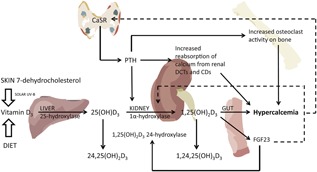Figure 1.

Hormonal regulation of extracellular calcium homeostasis. PTH is the principal calciotropic hormone, and acts to elevate calcium levels by promoting osteoclastic activity on bone, increasing reabsorption of calcium from renal distal tubules and collecting ducts, and stimulating renal enzyme 1α‐hydroxylase conversion of 25(OH)D3 into the active 1,25(OH)2D3. 25(OH)D3 is produced from vitamin D3, formed by the action of solar UVB on the skin or taken in through the diet, by the liver enzyme 25‐hydroxylase. 1,25(OH)2D3 is released into the circulation and stimulates calcium uptake from the gut. Rising serum calcium levels are detected by the CaSR, which facilitates a negative feedback on the parathyroid glands and PTH secretion attenuates to maintain homeostasis. 1,25(OH)2D3 is also regulated by FGF23, the main function of which is to regulate plasma phosphate concentrations. It is secreted by osteocytes in response to an elevated 1,25(OH)2D3 concentration and acts on the kidney proximal tubules to inhibit reabsorption and increase excretion of phosphate. It also inhibits 1α‐hydroxylase, thereby exerting a negative feedback on 1,25(OH)2D3 and promotes the action of 1,25(OH)2D3 24‐hydroxylase, leading to lower levels of 1,25(OH)2D3 and reduced calcium absorption from the gut. 25(OH)D3 = 25‐hydroxyvitamin D3; 1,25(OH)2D3 = 1,25‐dihydroxyvitamin D3; CaSR = calcium‐sensing receptor; FGF23 = fibroblast growth factor‐23; PTH = parathyroid hormone.
